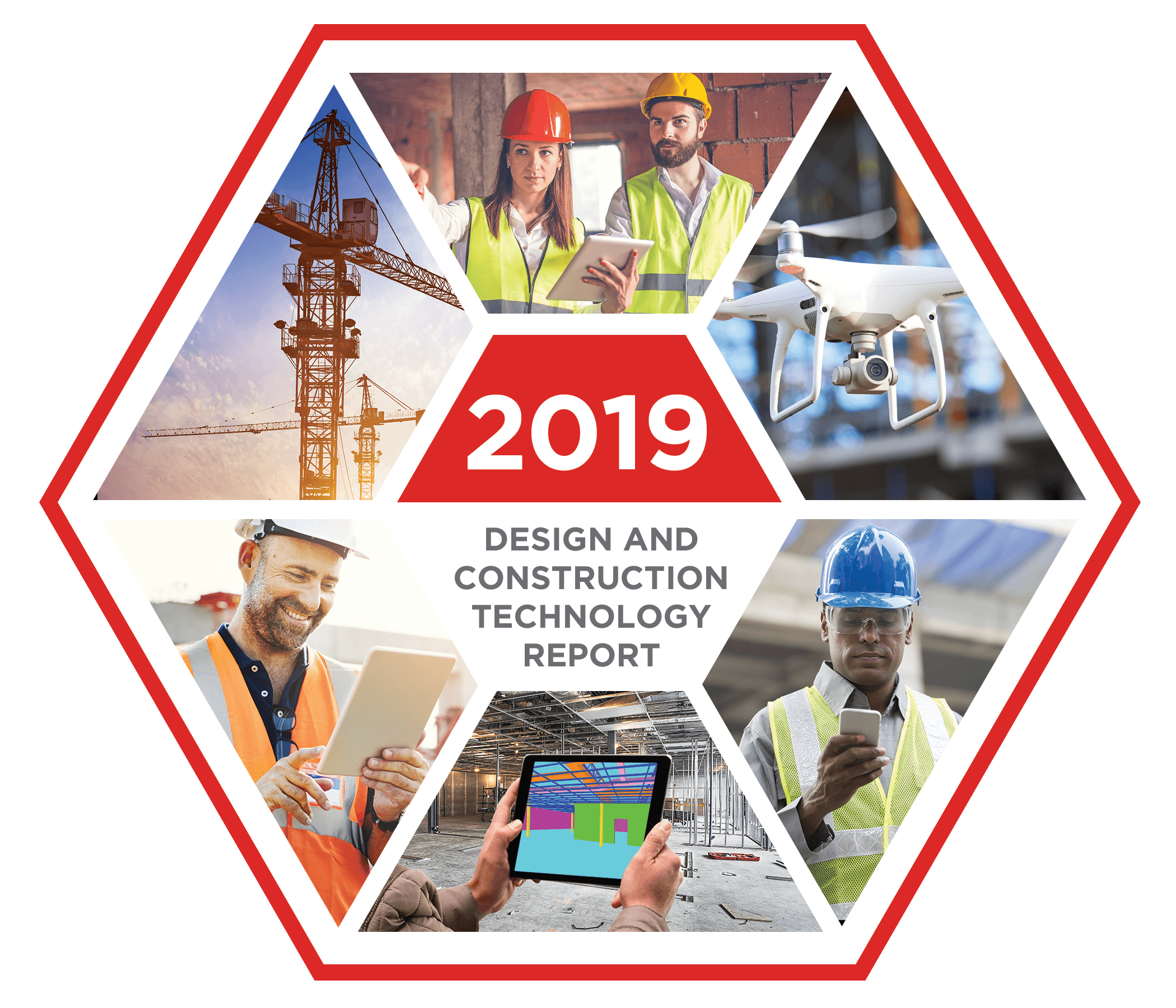Over the last two decades, ARC Documents Solutions has morphed from being a print-based information provider to a full-service document management platform, providing solutions not only to its base of architecture, engineering and construction (AEC) customers, but also for facilities managers and organizations in general.
With locations across the US and Canada, the Walnut Creek, CA-based company’s traditional customer foundation of AEC companies still is a mainstay. To help the industry move forward, ARC recently conducted a technology survey of AEC professionals, the details of which are outlined in its 2019 Construction Technology Report.
Conducted in January 2019, the company surveyed 330 subcontractors, contractors and architects to gauge their use of technology and how well it is working for them. The thrust of the survey was to pinpoint some of the challenges that are impeding successful delivery of projects; it also was meant to determine why greater project delivery success hasn’t been achieved by such companies, given the many tech tools available to them.
Some takeaways include the fact that many of those interviewed felt they were being overcharged for their tech tools, partly because they weren’t using the software to its greatest capabilities. Even many of those surveyed who use Building Information Modeling (BIM) found that using BIM to deliver on-time projects was still beyond their reach. Part of the disconnect was due to companies not having enough tech-savvy staff to handle workflows, lack of integration between apps, and “siloed” information resulting from the use of several different apps for a project.
AEC pros can expect more survey results from ARC in the future, and a longer, more nuanced view of the how the industry is adapting and changing with the help of technology over time.
“This is our inaugural survey and we will continue to take a deeper dive with our customers and share those findings with all, so the whole design and construction industry can gain from those insights, to transform productivity on their projects,” says Kumar Wiratunga, Corporate VP of Technology Solutions for ARC.

Kumar Wiratunga
AEC Next News recently spoke with Wiratunga about some of the lessons to be gleaned from the report.
Why was the focus of this survey to identify obstacles to productivity?
Wiratunga: “The design and construction [sector]has been challenged to drive productivity higher, and despite the technology innovations, our customers are not seeing the productivity gains expected. So, we wanted to survey our customers to understand the underlying reasons why there was such a lack of productivity gain.”
What are the largest such obstacles that you found?
Wiratunga: “There were some common threads: Some obstacles include consolidating solutions to eliminate data silos; rapid deployment [of tech tools]to realize benefits quickly; and providing actionable project intelligence to the team. Other productivity obstacles include the inability to hire needed talent; not having easy-to-use technology to drive adoption; and the need to augment teams with outsourced staff to meet demand.”
Why are just 60% or fewer project management features being used by the AEC pros you surveyed?
Wiratunga: “Either they are legacy products, or they are current products that have bloated feature sets that users find hard to use, or [which have]those features that are not much in demand but may look good on product comparison. So, choosing a solution that has the core functionality your team needs to be productive should be considered over how many features a product has, or if a product can handle one off or rarely applicable use cases.
Why does siloed info continue to be a problem for folks in AEC?
Wiratunga: “Customer are using more than four distinct solutions to meet their workflow. When combined with the reality that these solutions don’t [integrate], and instead, a manual data exchange process is being used to sync information, it creates data silos that cause duplicate data entry, errors and delays.
How is it that only 30% of Building Information Modeling projects meet deliverables deadlines? That seems ridiculous, given the versatility of BIM.
Wiratunga: “As more project owners demand BIM from Design and Construction professionals, the ability to keep up with the fast track nature of the project updates and readiness for the next coordination meeting is lacking. Our findings show that partnering with a BIM Services company can augment a firm’s internal team and help meet those demands and drive productivity much higher.”
Why in the world are so many (40 percent) of respondents using four or more project management tools?
Wiratunga: “No single tool is able to address the entire workflow, so firms adopt a best of breed approach, causing multiple solutions to be used. Licensing costs also are a factor, where the entire project team may not be licensed on the primary platform, creating the need to use free or near-free solutions for file sharing, or even resorting to using Excel to manage construction workflows like Submittals or RFIs.”
Why are a quarter of respondents to your survey struggling to manage submittals and RFIs?
Wiratunga: “Keeping up with the document and information changes consumes a project team’s time. When time-constrained, they fall behind. Outsourcing the document updates and hyperlinking can alleviate this time pressure, allowing the project team to focus on what’s important: Eliminating the risks associated with falling behind.”
Why do so many companies still struggle to coordinate between office and field?
Wiratunga: “Solutions don’t sync the project information from the office to the field and vice versa efficiently enough, or they are not using a solution that meets this need. Using a file sharing site plus Word, plus Excel, plus SharePoint causes more problems in this area.”
You found that a lot of your respondents were having trouble searching for data in the applications they use for projects. What good is a digital archive of projects, if you can’t search for stuff in it?
Wiratunga: “Exactly. Files that are “Archived” are really in a digital landfill where the best expected level of organization might be by folders and file. The inability to find documents is a really key use case that can be solved with a purpose-built archiving solution for AEC. These solutions should be able to search by the project criteria and do a Google-like full text search on all the content. When there is litigation or discovery, these search tools help immensely.”
Your survey found that a small portion of projects are finished on time and within budget—WHY?
Wiratunga: “Given that most survey respondents stated that the three performance measures most often used are based on schedule, cost-sharing, and output, it’s clear that a significant number of AEC/O professionals fail to meet even their own performance measures. These budget overruns and project delays threaten profitability, both on projects and for construction firms themselves. Contributing factors include lack of easy to use software, lack of qualified staff, not leveraging outsourced partners to fill the gaps, lack of time to be proactive, and data silos created by using multiple solutions.”
It seems amazing that Closeouts are taking up to three months to complete, for a third of those you surveyed. How do you explain this?
Wiratunga: “No central document management solutions are positioned to gather all the data during the project, subcontractors delay in providing needed content, and also in delivering closeouts in printed form or on CDs. Using a platform during the project that encourages the collection of data, that leverages the hyperlinked documents at closeout, and delivering a mobile closeout dashboard on an iPad, takes this process from months down to as low as a week.”
Why is the admin workflow related to content overwhelming so many in the industry?
Wiratunga: “Simple keeping up with the construction documentation, plan updates, RFIs and Submittals are the issue. This is made worse by the data silos and use of generic tools like Box, Dropbox and Excel worksheets to facilitate a construction admin workflow. Using purpose-built, easy to use, easy to deploy solutions will go a long way to improving this issue.”
What were folks on your team surprised to learn from this effort?
Wiratunga: “We were surprised to learn that technology acquisition or deployment alone doesn’t move the productivity needle. To do so, it takes a more holistic look and solution that incorporates professional services that can augment your team, use of purpose-built solutions, and reduction in data silos. These are some of the keys to transforming productivity in design and construction.”
What is up with the disconnect with BIM use and a lack of productivity achieved from it?
Wiratunga: “BIM is delivering productivity but keeping up with the BIM deliverables on the project is causing loss of productivity. So, it’s not BIM, but rather the lack of expertise and resources to leverage it and keep up with the deliverable schedule that is the limiting factor.”
Should more companies consider outsourcing their BIM work? If so, how does that help a company adapt and improve?
Wiratunga: “Yes, outsourcing can augment your team while it is built up internally to meet the workload, or to meet spikes in demand even when you have a full complement of experts onboard. Outsourced firms also bring their best practices to bear, having worked with other firms and applications. Those innovations can contribute to a better project outcome.”
Why is functionality so limited in the digital archives of many companies?
Wiratunga: “If the archiving solution is a network or cloud drive that simply hosts the data, then it is not better than a Windows file structure. Using a purpose-built AEC archiving solution provides the mechanism to organize documents to index them for a Google-like search and provides a means for digital document retention schedules to be administered so the documents can be defensibly disposed or purged to meet your written retention schedule.”
Are more companies using drones for construction? If so, for what tasks?
Wiratunga: “Yes, they are using drones for project pursuits, inspections, marketing, jobsite tracking, and to monitor site conditions. Photogrammetry captures photos and video for these purposes, and more advanced sensor-based data can deliver even more valuable information from LiDAR, Thermal and IR sensors.”
Will the use of drones continue to accelerate, in your opinion?
Wiratunga: “Definitely. The construction vertical has demonstrated the largest YOY gains in the use of drones at jobsites and it will gain even wider adoption as we go forward. Overcoming the need to have trained pilots on staff, obtaining FAA licenses, and insuring the pilot and the drones are some of the obstacles, apart from these, there’s also the need for in-house pilots. The ability to leverage an existing drone pilot network that addresses all these needs makes drone adoption on a project a much easier proposition.”
What do AEC companies need to do to improve their workflows?
Wiratunga: “They need to prioritize easy-to-use project management solutions; leverage outsourced solutions for BIM, drones, hyperlinking and VR/AR; they should consolidate solutions to eliminate data silos; use a single, easy-to-deploy document and construction platform; and leverage software and AEC/O services to make smarter decisions.”
How can firms improve their ability to effectively use all of the data they are gathering while digitizing project info?
Wiratunga: “First, by keeping the end in mind before you start. Consider how the data will be used, by whom, when and how, and then crafting a solution that will deliver those results.”
What should industry execs take away from this report’s findings?
Wiratunga: “The promise of productivity gains can be realized. Companies need to be enablers of change and need to empower their teams to explore partnering with outsourced professionals, in order to increase productivity.”






